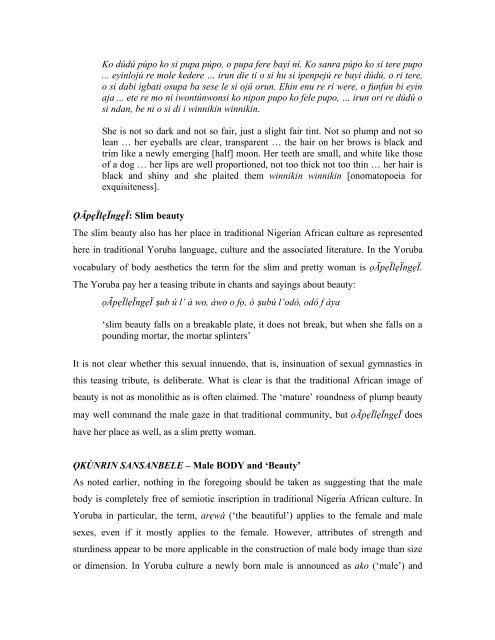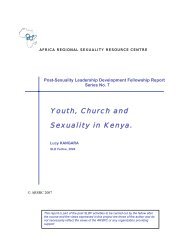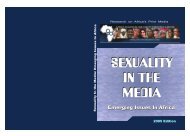body images beauty culture and language - Africa Regional ...
body images beauty culture and language - Africa Regional ...
body images beauty culture and language - Africa Regional ...
Create successful ePaper yourself
Turn your PDF publications into a flip-book with our unique Google optimized e-Paper software.
Ko dúdú púpo ko si pupa púpo, o pupa fere bayi ni. Ko sanra púpo ko si tere pupo<br />
... eyinlojú re mole kedere … irun die ti o si hu si ipenpejú re bayi dúdú, o ri tere,<br />
o si dabi igbati osupa ba sese le si ojú orun. Ehin enu re ri were, o funfun bi eyin<br />
aja ... ete re mo ni iwontúnwonsi ko nipon pupo ko fele pupo, … irun ori re dúdú o<br />
si ndan, be ni o si di i winnikin winnikin.<br />
She is not so dark <strong>and</strong> not so fair, just a slight fair tint. Not so plump <strong>and</strong> not so<br />
lean … her eyeballs are clear, transparent … the hair on her brows is black <strong>and</strong><br />
trim like a newly emerging [half] moon. Her teeth are small, <strong>and</strong> white like those<br />
of a dog … her lips are well proportioned, not too thick not too thin … her hair is<br />
black <strong>and</strong> shiny <strong>and</strong> she plaited them winnikin winnikin [onomatopoeia for<br />
exquisiteness].<br />
ỌÃpẹÏlẹÏngẹÏ: Slim <strong>beauty</strong><br />
The slim <strong>beauty</strong> also has her place in traditional Nigerian <strong>Africa</strong>n <strong>culture</strong> as represented<br />
here in traditional Yoruba <strong>language</strong>, <strong>culture</strong> <strong>and</strong> the associated literature. In the Yoruba<br />
vocabulary of <strong>body</strong> aesthetics the term for the slim <strong>and</strong> pretty woman is ọÃpẹÏlẹÏngẹÏ.<br />
The Yoruba pay her a teasing tribute in chants <strong>and</strong> sayings about <strong>beauty</strong>:<br />
ọÃpẹÏlẹÏngẹÏ ṣub ú l’ à wo, àwo o fọ, ó ṣubú l’odó, odó f àya<br />
‘slim <strong>beauty</strong> falls on a breakable plate, it does not break, but when she falls on a<br />
pounding mortar, the mortar splinters’<br />
It is not clear whether this sexual innuendo, that is, insinuation of sexual gymnastics in<br />
this teasing tribute, is deliberate. What is clear is that the traditional <strong>Africa</strong>n image of<br />
<strong>beauty</strong> is not as monolithic as is often claimed. The ‘mature’ roundness of plump <strong>beauty</strong><br />
may well comm<strong>and</strong> the male gaze in that traditional community, but ọÃpẹÏlẹÏngẹÏ does<br />
have her place as well, as a slim pretty woman.<br />
ỌKÙNRIN SANSANBELE – Male BODY <strong>and</strong> ‘Beauty’<br />
As noted earlier, nothing in the foregoing should be taken as suggesting that the male<br />
<strong>body</strong> is completely free of semiotic inscription in traditional Nigeria <strong>Africa</strong>n <strong>culture</strong>. In<br />
Yoruba in particular, the term, arẹwà (‘the beautiful’) applies to the female <strong>and</strong> male<br />
sexes, even if it mostly applies to the female. However, attributes of strength <strong>and</strong><br />
sturdiness appear to be more applicable in the construction of male <strong>body</strong> image than size<br />
or dimension. In Yoruba <strong>culture</strong> a newly born male is announced as ako (‘male’) <strong>and</strong>






